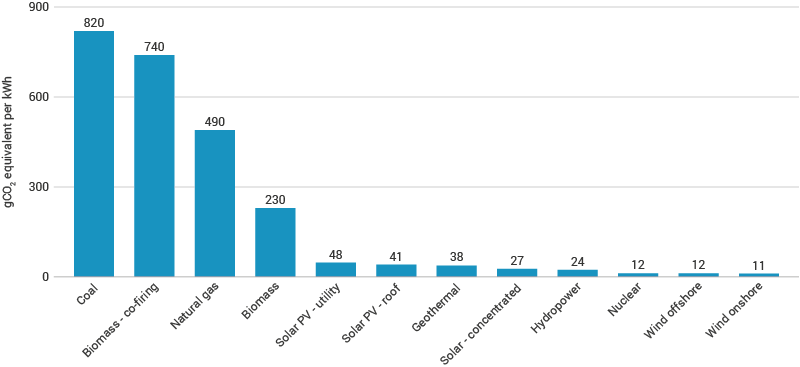What Is the Carbon Footprint of Oil Energy? A Life-Cycle Assessment
Impactful Ninja is reader-supported. When you buy through links on our site, we may earn an affiliate commission.
Learn more
Learn more
.
Hey fellow impactful ninja ? You may have noticed that Impactful Ninja is all about providing helpful information to make a positive impact on the world and society. And that we love to link back to where we found all the information for each of our posts. Most of these links are informational-based for you to check out their primary sources with one click. But some of these links are so-called "affiliate links" to products that we recommend. First and foremost, because we believe that they add value to you. For example, when we wrote a post about the environmental impact of long showers, we came across an EPA recommendation to use WaterSense showerheads. So we linked to where you can find them. Or, for many of our posts, we also link to our favorite books on that topic so that you can get a much more holistic overview than one single blog post could provide. And when there is an affiliate program for these products, we sign up for it. For example, as Amazon Associates, we earn from qualifying purchases. First, and most importantly, we still only recommend products that we believe add value for you. When you buy something through one of our affiliate links, we may earn a small commission - but at no additional costs to you. And when you buy something through a link that is not an affiliate link, we won’t receive any commission but we’ll still be happy to have helped you. When we find products that we believe add value to you and the seller has an affiliate program, we sign up for it. When you buy something through one of our affiliate links, we may earn a small commission (at no extra costs to you). And at this point in time, all money is reinvested in sharing the most helpful content with you. This includes all operating costs for running this site and the content creation itself. You may have noticed by the way Impactful Ninja is operated that money is not the driving factor behind it. It is a passion project of mine and I love to share helpful information with you to make a positive impact on the world and society. However, it's a project in that I invest a lot of time and also quite some money. Eventually, my dream is to one day turn this passion project into my full-time job and provide even more helpful information. But that's still a long time to go. Stay impactful,Affiliate Disclosure
Why do we add these product links?
What do these affiliate links mean for you?
What do these affiliate links mean for us?
What does this mean for me personally?
![]()
We have relied on oil for transportation since the mid-1900s. But, at the same time, the oil industry is responsible for emitting billions of tons of carbon dioxide into our atmosphere every year. So we had to ask: What is the carbon footprint of oil energy?
Oil has the highest carbon footprint of all energy types. Per kWh produced, oil emits 970 grams of carbon dioxide (CO2) on a life-cycle basis. It directly contributes to climate change, has various negative environmental effects, and is considered dirty energy.
Oil energy makes up around 24% of total US energy consumption and has various environmental implications. Keep reading to learn about the overall carbon footprint of oil and its carbon footprint throughout its life-cycle.
How is Oil Energy Defined
Oil energy comes from the combustion of petroleum, a fossil field also known as crude oil. Oil was formed millions of years ago when plant and animal remains gradually built up on the earth’s surface and the ocean floor, mixing with sand, silt, and calcium carbonate. Under immense heat and pressure, some of these remains were converted into oil depending on the combination of organic matter present, how long it was buried, and pressure conditions.
“Oil: petroleum (= the black oil obtained from under the earth’s surface from which gasoline comes)”
Cambridge Dictionary
Oil is referred to as crude oil when it is first extracted and then as petroleum products after it has been refined and processed. Petroleum products made from crude oil include gasoline, distillates (diesel fuel and heating oil), jet fuel, waxes, lubricating oils, and asphalt.
Oil is the world’s primary fuel source for transportation. In 2020, 18.12 million barrels per day (b/d) of oil were consumed in the US alone, this represents around 24% of total energy consumption. In terms of total petroleum consumption, gasoline represented 44%, distillates 21%, hydrocarbon gas liquids (HGLs) 18%, and jet fuel 6%.
What is the Carbon Footprint of Oil Energy
The carbon footprint is one of the ways we measure the effects of human-induced global climate change. It primarily focuses on the greenhouse gas (GHG) emissions associated with consumption, but also includes other emissions such as methane (CH4), nitrous oxide, and chlorofluorocarbons.
“Carbon footprint: the amount of greenhouse gases and specifically carbon dioxide emitted by something (such as a person’s activities or a product’s manufacture and transport) during a given period”
Merriam Webster
Basically, it is the amount of carbon emitted by an activity or an organization. This includes GHG emissions from fuel that we burn directly (e.g., heating a home, driving a car) and GHG emissions from manufacturing the products that we use (e.g., power plants, factories, and landfills).
What Is the Overall Carbon Footprint of Oil Energy
Oil is considered dirty energy because of its carbon footprint. On a life-cycle basis, oil emits 970 grams of carbon dioxide (CO2) equivalent per kWh of electricity produced. Which is the highest carbon footprint of all energy types – and higher than all the other ones on the illustration below.

The world collectively emitted 12.36 billion tons (bt) of CO2 from oil in 2019.

The top 10 largest oil producers in the world account for 72% (67 million barrels per day (mb/d)) of global oil global production, which is approximately 94 mb/d total.
The top 6 oil-producing countries (% share of world total) in the world are:
- United States (US) – 20%
- Saudi Arabia – 11%
- Russia -11%
- Canada – 6%
- China – 5%
- Iraq – 4%
Because oil has been one of the most in-demand global fuel sources since the 1920s, it is important to understand what its carbon footprint is and how its carbon emissions affect the global climate change process.
To understand the carbon footprint of oil energy, we must assess its life-cycle and each stage’s carbon footprint. This life-cycle assessment (LCA) is a method to evaluate the environmental impacts of products and materials. Over the years, companies have strategically used LCA to research and create more sustainable products. So, let’s have a look at the LCA of oil energy!
| The life-cycle stages of oil energy | Each stage’s carbon footprint |
| Building of oil energy | CO2 emissions from oil extraction and refinement; construction of oil-fired plants; transportation of oil to refineries and plants |
| Operating of oil energy | CO2 emissions fromoil combustion; operation of mechanical equipment at plants |
| Building back of oil energy | CO2 emissions from plugging wells and decommissioning power plantsCH4 seepage from unplugged wells |
The total carbon footprint of oil energy would equal the carbon footprint from building + the carbon footprint from operating + the carbon footprint from building back.
What Is the Carbon Footprint of Building Oil Energy
Building oil energy includes drilling, refinement, construction of the power plant, and transportation from drill sites to power plants.
Oil and natural gas (NG) are often found within the same reservoir, so they are often extracted in the same manner. Drilling or fracking exposes oil reservoirs for extraction.
Extracting oil involves seven main steps:
- Preparing the rig site
- Drilling
- Cementing and testing
- Well completion
- Fracking
- Production and fracking fluid recycling
- Well abandonment and land restoration
Once the oil is extracted and separated from the NG, it is transported via pipeline to refineries where it is broken down into various components and reconfigured into new products. These new products include fuel for transportation, heating, paving roads, electricity, and feedstocks for making chemicals.
Oil refinement occurs via the following steps:
- Distilling: Crude oil is heated until it becomes a vapor. The vapor is lifted upwards in a distilling column and collects at different levels in trays, separating the liquids. Lighter products (butane) rise to the top of the column whereas gasoline, naphtha, kerosene, diesel, and heavy gas oil collect in trays going from top to bottom in the column.
- Cracking: Because there is a demand for lighter distilled products like gasoline, refineries convert heavy liquids into lighter liquids via cracking. Cracking breaks up long hydrocarbon chains into smaller ones, converting heavy oil into gasoline. Cat cracking, catalyst-driven cracking, is the most common form of cracking.
- Reforming: Refineries again use a catalyst to increase the quality and volume of gasoline. Reforming increases the octane number by rearranging the naphtha hydrocarbons to create gas molecules. A high octane number is more beneficial because it can withstand more compression before detonating. And the higher the octane number, the more stable the fuel.
- Treating: Crude oil contains pollutants including sulfur, nitrogen, and heavy metals that must be removed. The treating process removes these pollutants either by binding them to hydrogen, absorbing them in columns, or adding acid to them.
- Blending: Finished petroleum products are a blend of various streams of hydrocarbons that are then mixed into motor fuels. Refineries can also mix additives such as octane enhancers, metal deactivators, anti-oxidants, anti-knock agents, rust inhibitors, or detergents.
After refinement, the oil is transported to a power plant (an oil-fired plant) or directly to consumers by tanker, truck, or railroad tank car, all of which generally run on diesel fuel. And burning one gallon of diesel fuel, to transport oil, produces 22.38 pounds of CO2.
Oil-fired plants have many components, and building these components requires machinery that emits CO2. Boiler rooms, smokestacks, cooling towers, generators, and turbines are all components with a carbon footprint.
What Is the Carbon Footprint of Operating Oil Energy
Emissions at this stage occur upon combustion of oil and are also associated with the operation of the mechanical equipment (e.g., turbines and generators) at the oil-fired plant.
Oil-fired plants operate in the same way as other fossil fuel power plants, where the heat generated from combustion turns water into steam which rotates turbines and drives generators to produce electricity. Burning oil emits anywhere from 139-161 lbs of CO2 per million Btu depending on whether it is propane, gasoline, or diesel fuel.
What Is the Carbon Footprint of Building Back Oil Energy
Oil wells can produce for anywhere from 20-40 years. When a well is done producing oil it is plugged to stop the flow of methane to the surface. However, over 3 million abandoned oil and gas wells are unplugged in the US alone, and these wells leak millions of metric tons of methane into our atmosphere every year. Simply plugging these wells could reduce methane emissions by 99%, which would help mitigate global warming.
In some instances, the area surrounding the well can be restored. In offshore drilling, the program “Rigs-to-Reefs” topples old oil wells and leaves them on the seafloor, establishing an artificial reef that attracts barnacles, coral, clams, sponges, and other marine life. This method has virtually no carbon footprint because the existing well is not demolished.
What Role Does Oil Energy Play in Contributing to Climate Change
Climate change is arguably the most severe, long-term, global impact of fossil fuel combustion. Every year, approximately 36 bt of CO2 are emitted from burning fossil fuels. 12 bt (34%) of this comes from oil. The carbon found in fossil fuels reacts with oxygen in the air to produce CO2. This warms the earth by acting as a heating blanket, and a warmer earth comes with a host of negative side effects.
CO2 emissions contribute to climate change in the following ways:
- Increasing temperatures: Earth’s atmosphere has warmed 1.5℃ since 1880. This may not seem like a lot, but these degrees create regional and seasonal temperature extremes, reduce sea ice, intensify rainfall and drought severity, and change habitat ranges for plants and animals.
- Rising sea levels: Global sea levels have increased approximately 8-9 inches since 1880, displacing people living along coastlines and destroying coastal habitats. Roads, bridges, subways, water supplies, oil and gas wells, power plants, sewage treatment plants, and landfills remain at risk if sea level rise goes unchecked.
- Melting of sea ice: Since 1979 arctic sea ice has declined by 30%. Sea ice plays a major role in regulating the earth’s climate by reflecting sunlight into space and providing habitat for animal species. If all of the glaciers on Earth melted, sea levels would rise by approximately 70 feet, effectively flooding out every coastal city on the planet.
- Changing precipitation patterns: Extreme weather events (e.g., hurricanes, floods, droughts) are becoming more common and more intense. Storm-affected areas will experience increased precipitation and flooding whereas areas located further from storm tracks will experience decreased precipitation and droughts.
- Ocean acidification: The ocean absorbs 30% of the CO2 released into the atmosphere, which decreases the pH (increases the acidity) of the ocean. In the past 200 years, the pH of oceans has decreased by 0.1 pH units, which translates to a 30% increase in acidity. Aquatic life unable to adjust to this rapid acidification will die off. A prime example of this is coral bleaching, where coral expel the algae (zooxanthellae) living in their tissues as a result of changes in temperature, light, or nutrients.
The more we reduce CO2 emissions, the more we slow the rate of temperature rise, sea-level rise, ice melting, and ocean acidification. When these rates are slowed, the earth’s biodiversity does not have to struggle to adapt to temperature and pH changes. People will not be displaced due to the flooding of coastal areas. And icebergs will continue to provide climate regulation.
How Environmentally Friendly Is Oil Energy
Oil is (still) our primary energy source for transportation, but its combustion produces over 12 bt of CO2 emissions annually, contributing significantly to global climate change.
“Environmentally friendly: (of products) not harming the environment.”
Cambridge Dictionary
Oil is not environmentally friendly. It is considered a dirty fuel source because of its high rate of CO2 emissions, toxic heavy metals, and other chemicals that contribute to global climate change. Although there are ways to minimize its environmental impact, there are still many environmental drawbacks.
What Are Environmental Drawbacks of Oil Energy
Understanding oil’s various environmental drawbacks is important to protect the environment.
- Oil Spills: Small oil spills occur when refueling a ship, and large oil spills occur when pipelines break, oil tankers sink, or drilling operations go wrong. Oil spills, in general, cause serious environmental harm by contaminating water and soil, causing explosions and fires, harming wildlife, and contaminating seafood. When oil enters the environment it is difficult and expensive to remediate.
- Air Pollution: The oil industry contributes significant amounts of CH4, volatile organic compounds (VOCs), and air toxics into the environment which can cause respiratory problems and even premature death. Methane has a global warming potential of more than 25 times that of CO2. VOCs are a group of chemicals that lead to the formation of ground-level ozone (smog). Air toxics are suspected carcinogens and include benzene, ethylbenzene, and n-hexane.
- Fracking: Large amounts of water and potentially hazardous chemicals are required when fracking, which can decrease water availability for people and aquatic life and can result in leaks and spills of fracking fluids. Fracking also produces large amounts of wastewater which require treatment before disposal, and injecting it back underground can cause earthquakes that are large enough to be felt.
- Atmospheric CO2: Levels of CO2 in our atmosphere have increased as a result of human emissions since the beginning of the Industrial Revolution in 1750. Emissions increased steadily to 5 bt per year in the mid-20th century before increasing exponentially to more than 35 bt per year at the end of the 20th century. The global average amount of CO2 in the atmosphere was about 280 parts per million (ppm) in 1750 but today registers at over 400 ppm. By the end of the 21st century, this number is expected to exceed 900 ppm. Burning fossil fuels adds to this total, which in turn amplifies the greenhouse effect and causes global warming.
- Global warming: This phenomenon occurs when CO2 and other air pollutants absorb sunlight and solar radiation in the atmosphere, trapping the heat and acting as an insulator for the planet. Since the Industrial Revolution, Earth’s temperature has risen a little more than 1 degree Celsius (C), or 2 degrees Fahrenheit (F). Between 1880-1980 the global temperature rose by 0.07C every 10 years. This rate has more than doubled since 1981, with a current global annual temperature rise of 0.18C, or 0.32F, for every 10 years. Experts claim that to avoid a future plagued by rising sea levels, acidified oceans, loss of biodiversity, more frequent and severe weather events, and other environmental disasters brought on by the hotter temperatures, we must limit global warming to 1.5C by 2040.
The oil industry pollutes the air and water, adds to the total level of CO2 in our atmosphere, and expedites global warming. The easiest way to mitigate the environmental impact of oil is to simply not rely on it in the first place. Oil combustion releases toxic chemicals, heavy metals, CO2, and contributes directly to global warming.
What Are Ways to Make Oil Energy Less Environmentally Detrimental
To minimize the negative environmental impacts of oil, technological advances in drilling, production, and transportation of oil as well as strict safety and environmental laws and regulations must be enforced.
- Improved Technology: Satellites, GPS, and remote sensing technology can detect oil reserves underground which negate the need to drill multiple exploratory wells.
- Efficient Drilling Methods: Horizontal and directional drilling allows a single well to produce oil from a much larger area, reducing the overall number of wells needed.
- Controlling CH4 Leaks: Detecting, fixing, and repairing CH4 leaks from well-pads, processing plants, compressor stations, and large distribution facilities is crucial. Doing this can reduce CH4 output by 1.70-1.80 million metric tons per year. Plugging abandoned oil wells also prevents the seepage of methane into the atmosphere.
- Recycle Water and Use Efficient Production Practices: Fracking uses a large amount of water, so recycling water and avoiding utilizing freshwater sources can reduce water requirements. Constructing wells properly and maintaining them after drilling is complete is crucial for efficiency.
- Implement Practices that Reduce Risk of Induced Seismicity: Fracking can cause seismic activity that leads to earthquakes. Avoiding water injection into active fault lines, limiting injection rates, installing seismic monitors, establishing a protocol for when seismic activity is induced, and abandoning wells with seismic activity are all ways to mitigate this threat.
Following certain protocols and environmental mitigation practices can reduce negative environmental effects.
Final Thoughts
We have relied on oil for transportation and to make various products for a century, but oil has the highest CO2 emissions per kWh out of all fossil fuels. Its carbon footprint across the building, operating, and building back phases releases toxic chemicals and contributes heavily to global warming.
Although there are ways to reduce environmental impacts, oil spills, air pollution, and fracking can cause significant environmental degradation. Reducing oil consumption would benefit our health and our planet’s health.
Stay impactful,

Sources
- National Geographic: Petroleum
- US Energy Information Administration: Oil and Petroleum Products Explained
- Environmental and Energy Study Institute: Fossil Fuels
- US Energy Information Administration: Use of Oil
- Statista: Primary energy consumption in the United States in 2019 and 2020, by energy source
- Britannica: Carbon Footprint
- United States Environmental Protection Agency: System of Registries
- US Energy Information Administration: How much carbon dioxide is produced per kilowatthour of U.S. electricity generation?
- World Nuclear Association: Carbon Emissions from Electricity
- Our World in Data: CO2 emissions by fuel
- US Energy Information Administration: What countries are the top producers and consumers of oil?
- US Energy Information Administration: History of Gasoline
- Science Direct: Life-cycle assessment (LCA)
- MIT SMR: Strategic Sustainability Uses of Life-Cycle Analysis
- Coloradans for Responsible Energy Development: The seven steps of oil and natural gas extraction
- Library of Congress: Modes of Transportation – Oil and Gas Industry – A Research Guide
- US Energy Information Administration: Refining Crude Oil – The Refining Process
- American Petroleum Institute: Refinery Processes
- US Energy Information Administration: Gasoline Explained – Octane in Depth
- Natural Resources Canada: Learn the facts – fuel consumption and CO2
- US Energy Information Administration: How much carbon dioxide is produced when different fuels are burned?
- Coloradans for Responsible Energy Development: How long does fracking last?
- Forbes: Plugging Abandoned Oil Wells Is One ‘Green New Deal’ Aspect Loved By Both Republicans And Democrats
- Bureau of Safety and Environmental Enforcement: Rigs-to-Reefs
- The National Wildlife Federation: Climate Change
- National Oceanic and Atmospheric Administration: Climate Change – Global Temperature
- National Oceanic and Atmospheric Administration: Climate Change – Global Sea Level
- United States Geological Survey: How would sea level change if all glaciers melted?
- National Aeronautics and Space Administration, U.S.A.: How does climate change affect precipitation?
- National Oceanic and Atmospheric Administration: Ocean Acidification
- National Ocean Service: What is coral bleaching?
- Union of Concerned Scientists: The Hidden Costs of Fossil Fuels
- US Energy Information Administration: Oil and the Environment
- Natural Resources Defense Council: Reducing Natural Gas Leakage to Protect the Environment Is Easy to Do, Saves Money, and Creates Jobs
- Business for Social Responsibility: Fuel Sustainability Brief – Natural Gas
- National Oceanic and Atmospheric Administration: Oil Spills
- United States Environmental Protection Agency: Basic Information about Oil and Natural Gas Air Pollution Standards
- National Oceanic and Atmospheric Administration: Climate
- Change – Atmospheric Carbon Dioxide
- National Resources Defense Council: Global Warming 101




